Learn

Coastal Waters
Coastal waters are transition areas where freshwater and marine water come together. Inland, freshwater streams and rivers flow toward the shorelines and empty into the ocean. This creates transitional areas that include marshes, swamps, estuaries, tidal pools, beaches, and inlets.
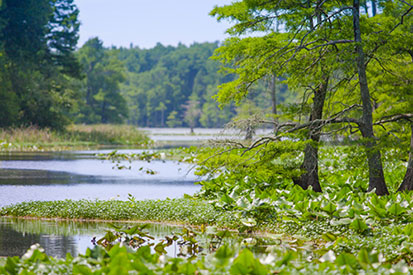
Many of these coastal areas have a mixture of fresh and marine water where salt content is greater than that of freshwater but less than that of ocean water. This mixture of water is often referred to as brackish water. Where the mixture occurs, the top part of the water has less salinity, and the salinity gets greater as you go down because the freshwater is less dense than the seawater. The salinity of these waters can change with the tides. At high tide, the saltwater pushes farther into the freshwater areas making them more salty. When the tide goes out, the salt concentration will decrease. This characteristic creates a unique variety of organisms that are adapted to live in these areas.

Estuaries
Rivers flow to the ocean and empty into the ocean at points called estuaries. Sometimes this area is referred to as the "mouth" of the river. Here freshwater combines with saltwater creating brackish water.
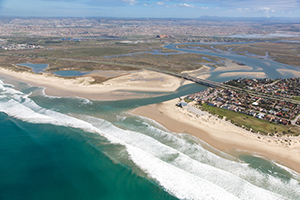
River mouth and estuary at ocean's edge
Estuaries provide great ecological, recreational, and economic importance to the United States. A wide variety of species depend on estuaries as their home, for food, and for reproduction. Many commercial saltwater fish depend on estuaries and wetlands for part of their life. They use these areas for spawning and reproduction.
Economic impact can also be seen through recreational use. Many people visit areas along the shoreline and around estuaries for vacation. They fish the waters and use the beach areas and coastline. This infuses brings in money into the local economy. Hotels and motels are rented to provide places to stay. Restaurants are visited to provide food. Licenses and permits are sold for fishing and boating.
Because people use these areas, there are risks to the environment. The waters are polluted through human use. Trash and litter is often a problem. Water pollution from the use of boats and other vehicles is a problem. Overfishing and poaching can also adversely affect the animals and plants in these areas.
Visit Estuary Biomes and USA Today Animals and Plants of the Estuary to read more about estuaries, the animals and plants of estuaries, and threats to estuaries.

Inlets
Inlets connect the ocean with a bay where freshwater and saltwater mix. The water level changes with the ocean's tides. As the tide rises, water rushes into the bay causing the water level to rise and salinity of the water increases. When the tide goes out low tide , water rushes back out toward the ocean causing the water level to drop. Inlets are responsible for controlling the salt concentration in bays. These are areas, much like estuaries, that have a variety of plant and animal species.
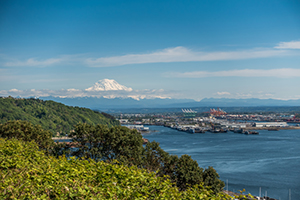

Tidal Pools
Tidal pools are much like inlets but typically on a smaller scale. Tidal pools form on beaches and shorelines. Tidal pools form in intertidal zones — areas between high tide and low tide. When the tide goes out during low tide, some water is trapped in low areas or areas contained by rocks. These tidal pools can be many different sizes. Tidal pools contain organisms such as crabs, sea urchins, and starfish. Many of these organisms will spend their entire life in one tidal pool.
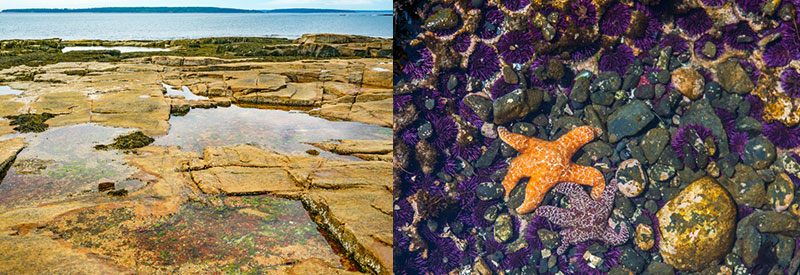
The National Park Service Tidepool Animals Photo Gallery shows examples of animals that live in tidal pools.

Wetlands
Estuaries tend to create areas of land behind them that are covered by water at least part of the year. These areas are known as wetlands. Wetlands include swamps, marshes, and bayous. These areas are important to migratory species as a source food and for breeding areas. These areas act as natural filters. As the water moves through these areas, the sediments and other pollution from runoff are filtered out making the water cleaner and clearer.

Foggy swamp in Mobile, Alabama
These wetlands help with flood control. They act like a natural sponge for the environment. During flooding the excess water is able to be soaked up by the wetland areas. Visit EPA Wetlands Types to see the different types of wetlands, types of organisms in each, their importance ecologically, and what threats to each.

Beaches
Beaches are areas where the ocean meets the land. Beaches are typically sand or rock covered. Beach area increases and decreases with the tides. At high tide, more of the beach is covered by water and at low tide, more beach area is exposed.
Beaches serve ecological, economic, and recreational purposes. Beaches are nesting grounds for turtles and seabirds. Many of the same animals that are found in estuaries, inlets, and tidal pools are also found along beaches. Crabs, clams, periwinkles, shrimp, corals, starfish and sea urchins are common on nearly all beaches. Beaches serve as buffer areas between the ocean and the inland. Dunes on beaches help protect inland areas from water during storm surges. Beaches are visited by people for recreational purposes, such as, fishing, sunbathing, and surfing. Many cities, regions, and even entire countries depend on money from tourists that visit beaches.
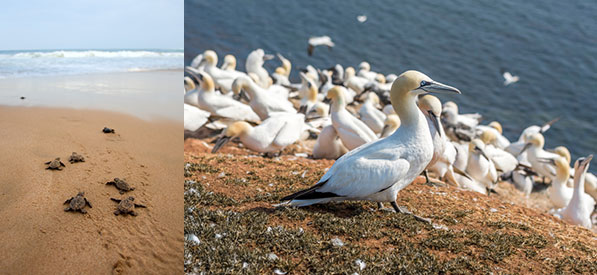
Beaches are nesting grounds for many turtles and seabirds, including
loggerhead sea turtles and northern gannets.
Because of the economic importance of beaches, people have often tried to control them. They build hotels, houses, and shops along the beaches in areas that are often vulnerable to storm surges and being washed away. Beaches are susceptible to natural erosion where the beach gets washed away by water, waves, and wind. Pollution from human activities also takes a toll on beach areas. Garbage that washes up on beaches can entangle wildlife killing them. Industrial waste can be dangerous to the many bottom feeders along the beaches. Human waste, as well as fertilizers, can cause alga blooms that deplete oxygen when they die.
Pollution from oil spills is the most deadly to beach areas. The oil washes on beaches covering smaller organisms quickly and eventually causing damage to the larger animals. It takes beaches years to recover from oil pollution. You will visit a site in Task #2 where you will read about the BP oil spill of 2010, what happened, how it was cleaned up, and what impact it had on the Gulf of Mexico ecosystems.
 |
 |